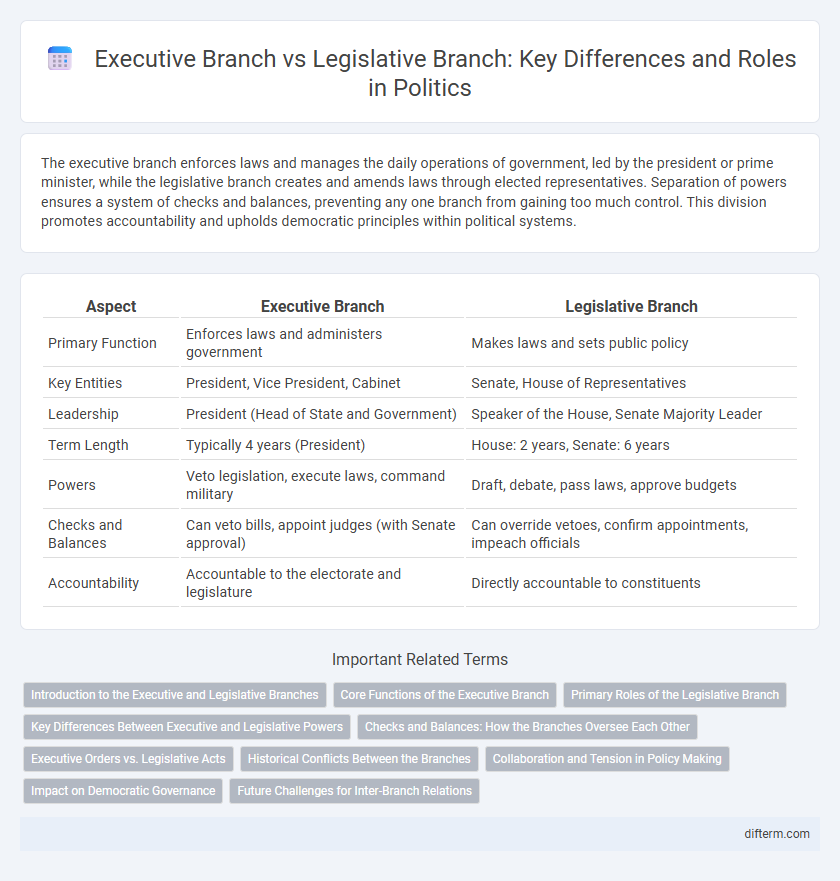The executive branch enforces laws and manages the daily operations of government, led by the president or prime minister, while the legislative branch creates and amends laws through elected representatives. Separation of powers ensures a system of checks and balances, preventing any one branch from gaining too much control. This division promotes accountability and upholds democratic principles within political systems.
Table of Comparison
| Aspect | Executive Branch | Legislative Branch |
|---|---|---|
| Primary Function | Enforces laws and administers government | Makes laws and sets public policy |
| Key Entities | President, Vice President, Cabinet | Senate, House of Representatives |
| Leadership | President (Head of State and Government) | Speaker of the House, Senate Majority Leader |
| Term Length | Typically 4 years (President) | House: 2 years, Senate: 6 years |
| Powers | Veto legislation, execute laws, command military | Draft, debate, pass laws, approve budgets |
| Checks and Balances | Can veto bills, appoint judges (with Senate approval) | Can override vetoes, confirm appointments, impeach officials |
| Accountability | Accountable to the electorate and legislature | Directly accountable to constituents |
Introduction to the Executive and Legislative Branches
The executive branch is responsible for enforcing laws, led by the president or prime minister, and oversees government agencies and the military. The legislative branch is tasked with creating laws, composed of elected representatives or parliamentarians who debate and pass legislation. These branches operate under a system of checks and balances to ensure no single branch wields excessive power.
Core Functions of the Executive Branch
The executive branch primarily enforces and administers federal laws, overseeing national defense, foreign policy, and day-to-day government operations. It includes the President, Vice President, Cabinet members, and federal agencies responsible for implementing legislation passed by the legislative branch. Core functions also encompass issuing executive orders, managing diplomatic relations, and serving as commander-in-chief of the armed forces.
Primary Roles of the Legislative Branch
The primary roles of the legislative branch include creating, debating, and passing laws that govern the nation. It holds the power to approve budgets, levy taxes, and oversee the executive branch through hearings and investigations. Representation of the public interest and balancing government power are fundamental functions embedded in legislative responsibilities.
Key Differences Between Executive and Legislative Powers
The executive branch enforces laws and directs government operations, led by the president or prime minister, while the legislative branch creates, debates, and passes laws through representatives or senators. Executive powers include vetoing legislation, conducting foreign policy, and commanding the military, contrasting with the legislative authority to approve budgets, declare war, and provide checks on executive actions. Separation of powers and checks and balances ensure that both branches function independently but cooperatively within a democratic system.
Checks and Balances: How the Branches Oversee Each Other
The executive branch has the power to veto legislation passed by the legislative branch, serving as a crucial check on congressional authority. Conversely, the legislative branch oversees the executive through mechanisms such as impeachment powers and the requirement of Senate confirmation for key appointments. These checks and balances ensure that no single branch can dominate the federal government, maintaining a distribution of power and accountability.
Executive Orders vs. Legislative Acts
Executive Orders are directives issued by the President to manage operations within the federal government, bypassing the need for congressional approval, which allows for swift policy implementation. Legislative Acts, passed by Congress and requiring presidential consent, provide binding laws with broader scope and legal authority than Executive Orders. While Executive Orders can be reversed by future administrations or challenged in courts, Legislative Acts establish enduring statutory frameworks influencing national governance.
Historical Conflicts Between the Branches
Historical conflicts between the executive and legislative branches have frequently shaped the balance of power in democratic governments, with landmark disputes such as the U.S. Watergate scandal exposing abuses of executive authority. Congressional efforts to check presidential power through investigations and impeachment proceedings have underscored tensions inherent in the separation of powers doctrine. These conflicts often reflect deeper struggles over constitutional interpretation and the scope of executive privilege versus legislative oversight.
Collaboration and Tension in Policy Making
The executive branch and legislative branch collaborate to shape policy by drafting, debating, and implementing laws that respond to public needs and national priorities. Tensions arise from differing political agendas, power struggles, and checks and balances designed to prevent overreach by either branch. Effective policy making depends on negotiation and compromise, with successful governance relying on the interplay between presidential leadership and congressional authority.
Impact on Democratic Governance
The executive branch enforces laws and administers public policy, directly influencing the effectiveness and responsiveness of democratic governance. The legislative branch creates laws and represents the electorate's interests, ensuring accountability and diverse participation in decision-making. Balancing power between these branches prevents authoritarianism and promotes transparent, inclusive democracy.
Future Challenges for Inter-Branch Relations
The future challenges for inter-branch relations will involve navigating increasing political polarization and the consequent gridlock between the executive branch and the legislative branch. Issues such as executive orders, legislative oversight, and budget approvals are likely to intensify disputes over the separation of powers. Technological advancements and cybersecurity threats will require enhanced cooperation to protect national interests amid evolving governance dynamics.
executive branch vs legislative branch Infographic

 difterm.com
difterm.com